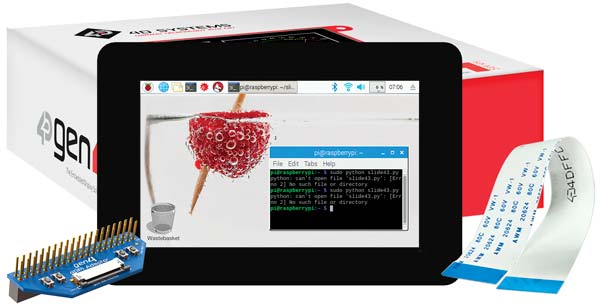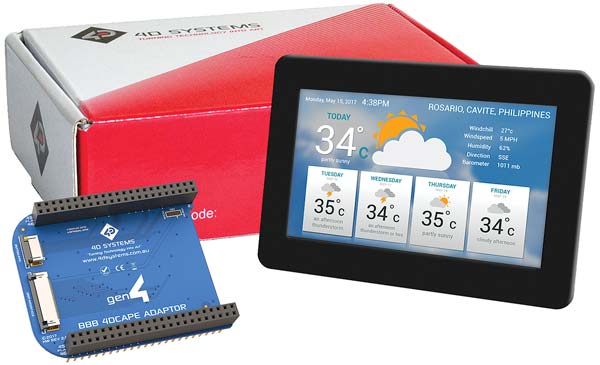 So-called intelligent displays already contain an integrated controller board including a graphics processor. They can thus be used without additional components such as PCs or single-board computers, both for display and device control with bidirectional communication. Especially for low or medium production volumes, they offer significant advantages over traditional displays. If all components have to be integrated individually, this takes a great deal of time and involves high development costs. The developers have to carry out every step of the design-in process themselves, from selecting suitable microcontrollers, graphics controllers and drivers, to board design, programming, testing and GUI (Graphic User Interface) development. Especially with smaller quantities, the costs and effort can quickly exceed the benefit or even the resources of a company.
So-called intelligent displays already contain an integrated controller board including a graphics processor. They can thus be used without additional components such as PCs or single-board computers, both for display and device control with bidirectional communication. Especially for low or medium production volumes, they offer significant advantages over traditional displays. If all components have to be integrated individually, this takes a great deal of time and involves high development costs. The developers have to carry out every step of the design-in process themselves, from selecting suitable microcontrollers, graphics controllers and drivers, to board design, programming, testing and GUI (Graphic User Interface) development. Especially with smaller quantities, the costs and effort can quickly exceed the benefit or even the resources of a company.
For example, use of a TFT display with a 4.3″ diagonal (cost approx. €40) including an independent design requires the deployment of two engineers for six months. A TFT display module (cost approx. €59), on the other hand, can be integrated into an application by a developer within about a month. Thanks to reduced development costs, the overall costs are reduced in this case despite higher unit costs for the display module. As many of the time-consuming development steps are eliminated, the time-to-market is drastically reduced.
 All-in-one solution with corresponding software
All-in-one solution with corresponding software
With its intelligent display modules, manufacturer 4D Systems offers such “one-stop” solutions for the embedded display sector. With their existing interfaces alone they enable countless extensive applications – without PC boards, which cause additional license costs for operating systems and whose functional scope exceeds requirements, especially for simple applications. For example, an intelligent display without an additional controller is sufficient for a fully-automatic coffee machine.
However, if the application is to perform complex calculations with database queries, use Internet-based data streams or contain high-performance sensors or actuators, a single-board computer (SBC) or host controller is required. For the connection of SBCs such as Arduino, Raspberry Pi or BeagleBone Black, 4D Systems display modules offer an adapter. In addition, they are compatible with microBus (M-Bus) boards and support microelectronic compilers and microSDK as well as MPLab and Atmel Start.
In order to use the display modules and create applications, 4D Systems offers the free “4D Workshop” software with four different modes: Designer mode allows 4DLG codes to be generated to program the display, while Serial mode allows the module to be converted to a slave device and controlled using any microcontroller host with a serial port. The “ViSi” and “ViSi-Genie” modes offer simplified visual programming with accompanying automatic 4DGL code generation.
Seamlessly scalable
Even after the initial creation of an application, the decision between simple displays and intelligent display modules has an effect on the development processes, because other processors are often used in new product generations. For traditional development with a chipset solution, this usually means that the GUI also needs to be adapted. In order to significantly reduce the amount of work this involves, 4D Systems has designed its development environment in such a way that the GUI is also fully supported by subsequent processors.
The same applies when the production volume increases. Manufacturers then often change display suppliers – for example, because they receive more favorable conditions. This generally means, however, that the previous programming has to be adapted to the chipset of the new display. With 4D Systems display modules on the other hand, increasing production volumes without having to invest in new software development is easy. This is because both small and large order quantities are possible and the chipsets remain compatible with the existing software.
 Standard modules and customer-specific adaptation
Standard modules and customer-specific adaptation
For large displays (1.38″ to 7.0″) – whether with or without touchscreens – 4D Systems uses TFT technology. For smaller displays without a touch function (0.96″ to 1.7″), OLED technology is used because it allows a much thinner structure. The TFT displays are optionally available as open frames or with a cover glass (cover lens bezel). If the display is to be mounted on the inside of the housing, an open-frame version with side mounting brackets is available. If on the other hand the display is mounted on the outside, the glass frame (cover glass) model can simply be glued into the housing.
All 4D Systems display modules are connected via an interface board (USB, 5V) and require a micro SD card to store the graphic content. In order to ensure the smooth functioning of the application, especially if data from the memory needs to be processed not only temporarily but permanently, it is strongly recommended that industrial memory cards be used. These have higher-quality underlying technology and thus offer more read and write cycles than basic “consumer cards”. This increases the reliability of the entire application. Such cards can be obtained from Swissbit or Apacer, for example.
With these features, the intelligent displays are particularly suitable for low-volume applications such as fully-automatic coffee machines, medical scales, dispensing systems, info displays for smart pedelecs, control panels for soldering and welding equipment in the jewelry sector, 3D printers and timing devices.
In conjunction with other embedded and wireless products, the display modules enhance a wide range of applications, e.g. air-conditioning systems with temperature displays that can also be used for touch-control.
The display modules are equipped with the serial interfaces I2C and SPI or RS-232 and RS-485.
The standard modules, which achieve a resolution of up to 800×480 pixels, already cover a wide range of applications. In addition, 4D Systems also meets customer-specific requirements, such as a certain brightness level or the anti-reflective coating of the display, as well as specific certifications for applications in medical technology or the automotive sector.

Author: Nikolai Schnarz,
Product Sales Manager
Professional Monitors & Applications
Rutronik | https://www.rutronik.com
![]()


